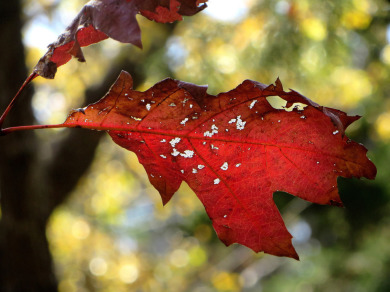If you’ve driven interstate 91 through Vermont from the border of Massachusetts in the south to the international border in the north with an eye on the trees along the road, you likely noticed changes along the way. You might have noticed just how predominant Red Oak (Quercus rubra) is in the south and how it slowly disappears as you cruise northward until it is completely missing when you reach the border.
In 2001 ecologist Brett Engstrom wrote about Red Oak distribution in the Upper Winooski River watershed in northeastern Vermont for the newsletter of a local naturalists club. I was fascinated by his observations. Here was a tree that was considered to be common in much of Vermont and both economically and ecologically important in some areas, yet we really didn’t have a good understanding of it’s biogeography throughout the state. Engstrom made careful note of where he found oaks scattered in the forest over several decades in his region. Here at the edge of their range he found them on rocky, south facing slopes and as high as 2,110 feet in elevation in one place.
Charlie Cogbill, a forest ecologist living in the same region, has used survey witness trees from the time of first european settlement to understand what the forests of New England may have looked like. Red Oak was a very uncommon tree, it was found mostly in the lower portion of the Connecticut River valley, southernmost Vermont borderlands and the Champlain Valley. As Engstrom noted, perhaps oaks expanded after European settlement as they can grow well in abandoned fields and are dispersed widely by Blue Jays carrying and storing acorns.
Red Oak may be poised to move northward again. Climate change forecasts for tree distribution suggest Red Oak will move northward and increase in abundance in Vermont. Engstrom concluded his article with a plea for more observations to capture a more detailed picture of oak distribution in the region. With the Vermont Atlas of Life, we are poised to do just that. Already, naturalists like you have contributed over 135 observations of Red Oak in Vermont in the Vermont Atlas of Life, but we’d like to gather thousands of observations across the state.
You’re mission is to record as many observations of Red Oak throughout Vermont as possible in the Vermont Atlas of Life. It is a relatively easy species to identify, and since oak retains its leaves much longer than most hardwoods, it is easy to identify from afar as autumn progresses. What is the highest elevation you can find it in your town? How many woodlots have oak in your neighborhood? Let’s build a detailed red oak distribution map of Vermont together this fall! Together, we can create a basemap of oak distribution for comparison now and into the future.


I was just reading in the latest issue of Northern Woodlands, how red oak is really marching northward! Keep up your awesome and important work! Your Vermont Atlas of Life looks like a real model for other states; I wish they’d be doing likewise!
Thanks Hillel! We hope to keep developing this and get other regions to join in for sure!
I live near lake dunmore and there are lots of red oak. But there has been alot of clearing going on
I’ve just found a small red oak sapling in the woods near my home in Rochester, VT.